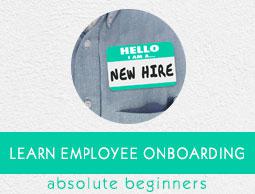Employee Onboarding - Objectives
Onboarding is an orientation process in which new resources get the important information, aptitudes, and practices to become distinctly viable authoritative individuals and insiders. Onboarding prompts to positive results for new workers, for example, higher job satisfaction, better work performance, and longevity in their positions.
Through a well-structured onboarding process, employees gather required knowledge, retention level high in the larger interest of the organization.

A positive onboarding process helps to fulfill the following objectives −
- Facilitate the new employee’s ability to contribute in the new role.
- Increase the new employee’s comfort level in the new role.
- Reinforce his/her decision to join the organization.
- Enhance productivity.
- Encourage commitment and employee engagement.
Onboarding starts even before someone new is hired. It continues when a person is hired and when he/she starts working. A well-designed onboarding continues for a while after the new employee starts working in the organization. In other words, onboarding starts before the organization makes sure the physical environment for the new recruit begins.
Purpose of Employee Onboarding
Unless the new recruits develop a sense of acquaintance with the organization, they cannot give productivity as desired. Hence, onboarding holds utmost importance in the smooth functioning of the organization.
The purpose of an onboarding program is to develop within the new recruits the necessary skills, knowledge and behaviors to become an effective contribution to the organization he/she works with.
The following are the important purposes of onboarding −
To attract and retain good talent.
To enhance employee engagement, thereby giving a boost to business growth.
Make employees feel welcome and valued.
Create alignment to task, mission, culture, values and processes.
Decrease the learning curve.
Encourage socialization and create a sense of belonging.
Set of performance expectations.
Help employees learn the company culture quickly.
Allow the employee to understand the company's values and priorities.
Reduce new employee anxiety.
An effective onboarding program educates and informs new hires about organizational practices. Implementing an onboarding program cements the relationship between the employee and the employer from the beginning and opens up lines of communication and keeps the employees engaged in the long term.
Making Employees Feel Welcome
Putting aside the pecuniary ambitions of the employees, there are many intangibles that make people get satisfied with their jobs. Feeling a part of a team, experiencing a congenial work environment and get timely and just acknowledgement goes a long way in ensuring job satisfaction to the employees.
Studies conducted by the Corporate Leadership Council show it's critical for new hires to rapidly adjust to their new workplace. It's additionally essential for these new hires to begin building rapport with associates and colleagues so that they can start to absorb themselves into existing workgroups.
Onboarding can be lonely but it doesn’t have to be a solo venture, and HR professionals are not the only ones with the power to make the new kid on the block feel comfortable. Existing employees can do their part to help new hires feel welcome in their new work environment.
Here is a list of some creative ways to get the team involved in the onboarding process −
- Creating welcome traditions
- Giving a team-led tour
- Using the buddy system
Getting the team involved in the onboarding process is critical because it brings employees both new and old closer together and office friendships breed better work and happier employees. According to a research and a report, employees with friends at work are 47 percent more likely to love their companies.



